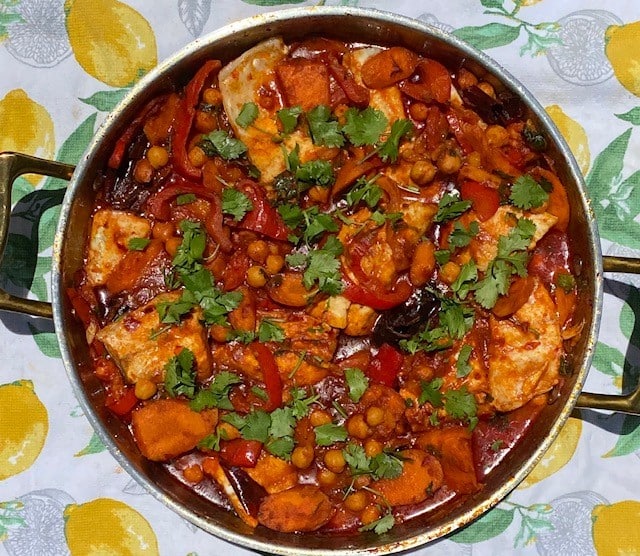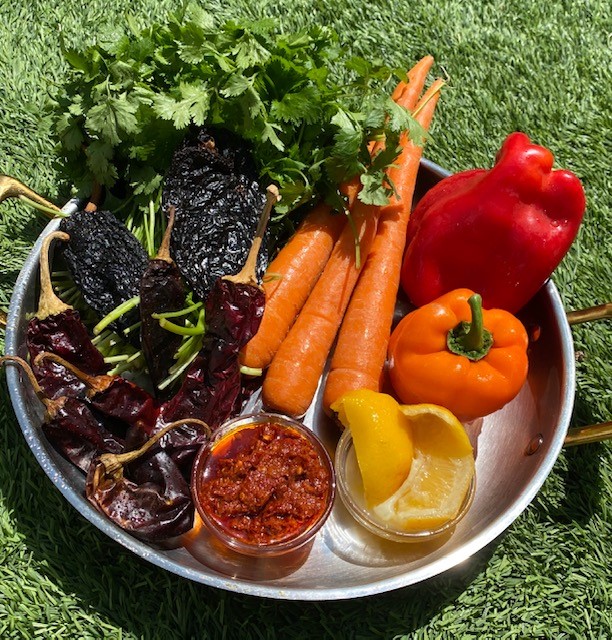
Majestically perched at the northwest tip of Africa, Morocco is blessed with more than 1,000 miles of sparkling coastline and an expansive desert interior. Its proximity to the Mediterranean Sea, the Atlantic Ocean and the Iberian Peninsula put it at the crossroads of ancient civilizations. The Berbers, Phoenicians, the Carthaginian state, the Romans, Muslims, Spanish, Portuguese and French have left their unique mark on Moroccan culture and cuisine.
The Moroccan Jewish community dates back 2,500 years. In the late 1490s, when the Spanish crown decreed that all Jews forcibly be converted to Christianity or face expulsion, Morocco proved to be a safe haven for the Jews. The Jews also made great contributions to the vibrant Moroccan tapestry.
By 1948, there were 250,000 Jews living in the mellahs (so named for the salt marsh of the original walled Jewish neighborhood created by the sultan near his palace in Fez) in the big cities of Casablanca, Marrakech, Rabat and Sale. Today there are only 2,000 Jews left. When they dispersed to France, Israel, Canada and other corners of the globe, the Moroccan Jews brought their recipes for dafina, couscous and bastilla with them. But it is Moroccan fish that has won its way into the diets of many Jews around the world.
The magic and mystery of the Moroccan souk, with its labyrinthine alleys, exotic ingredients, plentiful spices and fiery dried peppers inspire the intense flavors of the sauce. The sheer abundance of fresh fish like perch, sea bream, mullet and tuna in the waters around Morocco provided the perfect ingredients for the addictive raptures of Moroccan fish.
Friday night fish is kind of a big deal in Moroccan homes. Jews make Kiddush on the wine, then instead of immediately making the ha-Motzi blessing on the bread, they recite the Shehakol bracha (the special blessing for liquid or protein) on the fish to show its important status in the meal.
The tradition of serving fish as the first course dates back to the days of the Talmud and the story it tells of Yosef Mokir Shabbat, an impoverished Jew who always honored Shabbat with the finest foods. There was a wealthy gentile who was warned by the local fortune tellers that a day would come when he would lose all his wealth to Yosef. The man sold everything and acquired the most rare and expensive gem that he could find. He had the precious stone set in his hat. One day, he was crossing a bridge and a strong gust of wind blew his hat into the water and was then swallowed by a fish.
One Friday afternoon, a desperate fish merchant was trying to sell his catch before Shabbat. Yosef came and purchased the large, tasty-looking fish. When he opened the fish, he found the fabulous diamond. The Talmud states that he merited this great wealth because of the way he honored Shabbat.
The gematria (numeric value) for the word Dag (fish in Hebrew) is 7, representing the seventh day of the week.
Eating fish on Shabbat is also symbolic of the giant Leviathan that we will eat when the Mashiach arrives.
Rachel’s turn: Traditionally eaten as the first course every Friday night at the North African table, this fish dish has a rich, hearty, spicy, tomatoey stew that simply begs to be sopped up with freshly baked challah. We serve it with all the Moroccan salads, dips and olives.
When my siblings and I were younger, my mother made the fish less spicy, but as our palates developed, she cranked up the heat factor. The test of a true Moroccan is how much fire he can take in his or her fish. I have vivid memories of my uncle Menasse plucking the most super spicy pepper out of the fish. Harrif (spicy) was his thing.
The fiery depth of the sauce comes from the spicy harissa and dried peppers, smoky paprika and garlic melded with the exuberance of juicy tomatoes, sweet red peppers, cilantro and preserved lemons. Our family recipe includes carrots for sweetness and garbanzo beans to offset the spiciness. I use whitefish, halibut or sea bass, but several years ago, I saw some chefs were substituting salmon. I tried it and I loved it — salmon is a hearty fish that absorbs the flavors of the sauce without falling apart or becoming dry.
Try it with salmon, branzino, any white-flesh fish or the catch of the day. The fresher the fish, the better. This is real comfort food, Sephardic spice style.

Rachel’s Moroccan Fish
3 pounds of branzino, fileted and cut into 8 pieces
1/4 teaspoon salt, for salting fish
1/4 cup of olive oil
4 to 6 garlic cloves, finely sliced
1 tablespoon cumin
1 tablespoon sweet paprika
1 teaspoon salt, for sauce
1 teaspoon white pepper
1 red pepper, sliced in long thin strips
1 yellow pepper, sliced in long strips
3 medium carrots, cut into thick diagonal chunks
3 tablespoons tomato paste
2 tablespoons harissa or 2 teaspoons hot paprika
1/4 cup preserved lemon, finely diced or juice of one lemon
2 dried Mexican chiles of your choice
1 15 1/2-ounce can garbanzo beans, drained and rinsed
3/4 cup water
One bunch fresh cilantro, finely chopped
1/3 cup water
Rinse fish filets with cold water and pat dry.
Season fish with 1/4 teaspoon salt, place skin down on top of a few paper towels, then set aside.
In large, wide casserole with lid, warm oil over low heat and add garlic, spices, peppers and carrots. Sauté for 3 minutes to coat all vegetables with spices.
Add tomato paste, harissa, preserved lemon, dried chiles and chickpeas. Stir until all ingredients are coated with tomato and harissa, approximately 2 minutes.
Add 3/4 cup water, cover and simmer for 15 minutes, stirring occasionally to ensure sauce doesn’t stick to the pan.
With large spoon, move carrots and chickpeas to sides of pan to make space for fish. Add fish, then spoon a generous amount of sauce onto each piece.
Add chopped cilantro, reserving a handful for garnish.
Add 1/3 cup water, cover and simmer for another 8 to 10 minutes, depending on thickness of fish.
Fish can be re-heated in covered pan over low heat or in oven.
Add reserved fresh cilantro just before serving.
Serves 8.
Rachel Sheff and Sharon Gomperts would love to answer cooking questions on Instagram at SephardicSpiceGirls or on Facebook at Sephardic Spice SEC Food. They have collaborated on Sephardic Educational Center projects and community cooking classes.























 More news and opinions than at a Shabbat dinner, right in your inbox.
More news and opinions than at a Shabbat dinner, right in your inbox.